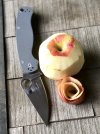Hickory n steel
Gold Member
- Joined
- Feb 11, 2016
- Messages
- 20,586
I never see all of these broken or ground to nothing knives in pawn shops. We must frequent different shops.That said, I find it really boring to root through a big pile of knives at a pawn shop. I don't see many bargains. What I see is a lot of Chinese junk.
My dinky little town has nothing and there are no pawn shops anywhere near me, any knives I find are at yardsales and the flea market or old school army surplus a town over.
I don't see as many knives as I would like but what I do are so often Chinese junk or just broken / ground down.


